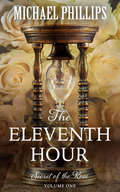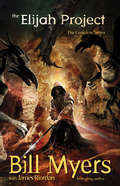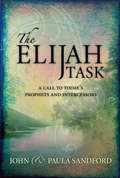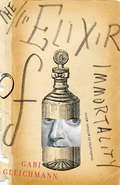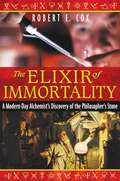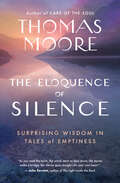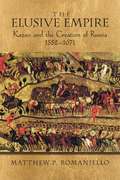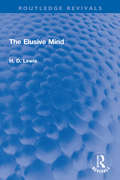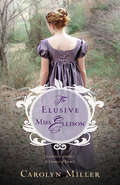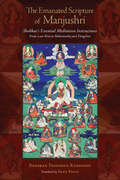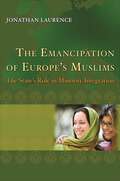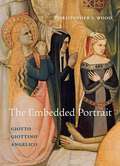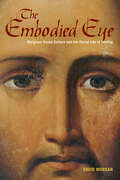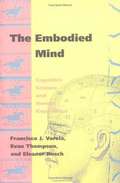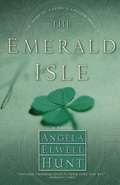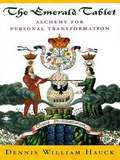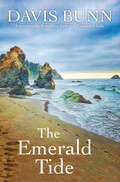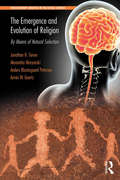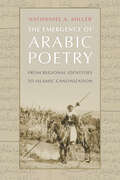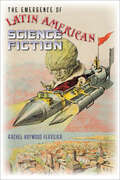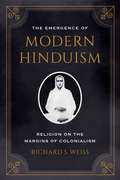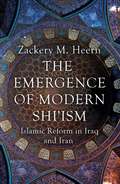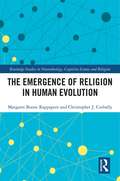- Table View
- List View
The Eleventh Hour (Secret of the Rose #1)
by Michael PhillipsFamily and faith guide one man through the buildup to World War II in this unforgettable saga—first in the Secret of the Rose series. In 1930s pre-war Prussia, Baron von Dortmann lives an idyllic life with his daughter Sabina. A devoted gardener and father, the Baron teaches his daughter powerful lessons about life, creation, and God&’s love during treasured walks in the estate&’s beautiful gardens. But Sabina is growing up, and the Baron&’s beloved Prussia is changing. Now a beautiful young woman, Sabina has caught the eye of a handsome young American, Matthew. Meanwhile, a cloud is gathering on the horizon as the Nazis seize power in neighboring Germany. As he strives to protect his family and follow his own moral compass, Baron von Dortmann will face heart-wrenching decisions, with only God&’s guidance to light the way.&“Watching Sabina and her parents in the Secret of the Rose series as they dealt with Nazi antagonism caused me to ponder exactly what it would have been like to live amongst such challenges. Sabina&’s zest for life and faith in God are encouragement to live in a way that honors the Lord, no matter what life-threatening challenges may arise.&” —Kindred Grace
The Elijah Project
by Bill MyersAfter finding a bizarre note from their parents, siblings Zach, Piper, and Elijah take a wild cross-country trip to find them. Unfortunately, Elijah’s supernatural gifts draw attention from the wrong people, and he is captured by the Shadow Man. It is up to Zach and Piper to save Elijah, but when they themselves are captured, will they be able to break free from the mesmerizing machine that promises them greatness? Or will they forever pay the cost of following darkness?
The Elijah Task: A handbook for prophets and intercessors (and for those who seek to understand these vital ministries)
by John Loren SandfordIt illumines the Bible like a searchlight, pointing out the mysteries of God. There still is much confusion and misuse of the office and the responsibilities of the prophet and the intercessor in the Christian arena. John and Paula Sandford explain how prophets are called and trained. With a great passion and urgency, they challenge all intercessors to realize and understand their vital role in the world today and how closely they must work with the prophets. John and Paula Sandford clearly explain:What it means to be called and trained as a prophet or intercessorHow to understand dreams and visions and hear directly from GodWhy it is important for the body to work in unityThis book is filled with spiritual discoveries that will effect dynamic changes in every reader.About the AuthorsJohn and Paula Sandford have applied the principles of this book with great success in their parenting of their children, grandchildren, and great-grandchildren. The founders of Elijah House, the Sandfords are well known around the world for their contributions of teaching, counseling, writing, and leading in the fields of family living, inner healing, prophecy, social concerns, human behavior, and theology. They have written thirteen books.
The Elixir of Immortality
by Gabi GleichmannA mesmerizing debut novel that spans a thousand years of European and Jewish history seen through the beguiling members of the Spinoza family Since the eleventh century, the Spinoza family has passed down, from father to son, a secret manuscript containing the recipe for immortality. Now, after thirty-six generations, the last descendant of this long and illustrious chain, Ari Spinoza, doesn't have a son to whom to entrust the manuscript. From his deathbed, he begins his narrative, hoping to save his lineage from oblivion. Ari's two main sources of his family's history are a trunk of yellowing documents inherited from his grandfather, and his great-uncle Fernando's tales that captivated him when he was a child. He chronicles the Spinozas' involvement in some of Europe's most formative cultural events with intertwining narratives that move through ages of tyranny, creativity, and social upheaval: into medieval Portugal, Grand inquisitor Torquemada's Spain, Rembrandt's Amsterdam, the French Revolution, Freud's Vienna, and the horrors of both world wars. The Elixir of Immortality blends truth and fiction as it rewrites European history through comic, imaginative, scandalous, and tragic tales that prove "the only thing that can possibly give human beings immortality on this earth: our ability to remember."
The Elixir of Immortality: A Modern-Day Alchemist’s Discovery of the Philosopher’s Stone
by Robert E. CoxA modern-day quest that echoes the ancient alchemists’ work to discover the elixir of life • Provides an overview of alchemical practices in the ancient world--from Europe to China • Reveals the alchemical secrets for creating this elixir in clear scientific language In 1989, while attempting to extract precious minerals from his property, a wealthy Arizonan obtained a mysterious white material that initially defied scientific attempts to identify it. After several years of testing, this substance was revealed to consist of gold and platinum--but in a form unknown to modern science. Further research showed that this powder, which had also been discovered to possess marvelous healing powers, contained monatomic forms of precious metals whose electron units had been altered to no longer display the physical, chemical, or electrical properties of the original elements. This substance, Robert Cox shows, bears eerie resemblance to the ultimate quest of the alchemists: the elixir of immortality. The mysterious material-spiritual science of alchemy was once pervasive throughout the ancient world, spanning the globe from China and India to Egypt and medieval Europe. In The Elixir of Immortality, Robert Cox reviews the alchemical lore of these traditions and the procedures each used to produce this fabulous elixir. Using his own alchemical research, Cox then reveals secrets that have been kept hidden for millennia uncovered in his own modern-day quest to rediscover this long-sought elixir of life.
The Elizabethan World Picture
by E. M. W. TillyardMy object then is to extract and expound the most ordinary beliefs about the constitution of the world as pictured in the Elizabethan age and through this exposition to help the ordinary reader to understand and to enjoy the great writers of the age. In attempting this I have incidentally brought together a number of pieces of elementary lore which I have not found assembled elsewhere. This book may actually be a convenient factual aid to the bare construing of some of Spenser or Donne or Milton.
The Eloquence of Silence: Surprising Wisdom in Tales of Emptiness
by Thomas MooreEMBRACING EMPTINESS, STAYING OPEN, FINDING CALM With compassion and insight, Thomas Moore offers a compelling case for an easier, lighter way of moving through life by experiencing the peace, calm, and openness of emptiness. Through ancient and modern stories, Moore gently shows that our constant multitasking may not be getting us anywhere, and that emptiness is not a lack but an invitation that can be our greatest teacher. A daily awareness and appreciation of the quiet spaciousness in our world and our own lives is not a retreat from reality but a rich and full welcome to all that is most meaningful and real.
The Elusive Empire
by Matthew P. RomanielloIn 1552, Muscovite Russia conquered the city of Kazan on the Volga River. It was the first Orthodox Christian victory against Islam since the fall of Constantinople, a turning point that, over the next four years, would complete Moscow's control over the river. This conquest provided a direct trade route with the Middle East and would transform Muscovy into a global power. As Matthew Romaniello shows, however, learning to manage the conquered lands and peoples would take decades. Russia did not succeed in empire-building because of its strength, leadership, or even the weakness of its neighbors, Romaniello contends; it succeeded by managing its failures. Faced with the difficulty of assimilating culturally and religiously alien peoples across thousands of miles, the Russian state was forced to compromise in ways that, for a time, permitted local elites of diverse backgrounds to share in governance and to preserve a measure of autonomy. Conscious manipulation of political and religious language proved more vital than sheer military might. For early modern Russia, empire was still elusive-an aspiration to political, economic, and military control challenged by continuing resistance, mismanagement, and tenuous influence over vast expanses of territory.
The Elusive Mind (Routledge Revivals)
by H. D. LewisFirst published in 1969, The Elusive Mind argues that the mental processes are of a quite different nature from physical ones and belong to an entity which is elusive in the sense that it can only be known, in the first instance, by each person in his own case in the course of having any kind of experience. This ‘elusive’ self is much involved with the body in any conditions we know, but it could also survive the dissolution of the body. The views of thinkers like Ryle, Hampshire, Malcolm, Feigl, and Ayer are subjected to an exceptionally close and critical scrutiny. In presenting these views, the author offers us the substance of the first series of Gifford Lectures he delivered in the University of Edinburgh; and, in what he says on such topics as dreaming; mysticism; and the ‘I-Thou’ relation and on Christian Theology. This book will be an essential read for scholars and researchers of philosophy, philosophy of mind, ethics, and religion.
The Elusive Miss Ellison (Regency Brides #1)
by Carolyn Miller"Handsome appearance counts for naught unless matched by good character and actions." That's the firm opinion of not-so-meek minister's daughter Lavinia Ellison. So even though all the other villagers of St. Hampton Heath are swooning over the newly returned seventh Earl of Hawkesbury, she is not impressed. If a man won't take his responsibilities seriously and help those who are supposed to be able to depend on him, he deserves no respect from her. In Lavinia's pretty, gray eyes, Nicholas Stamford is just as arrogant and reckless as his brother--who stole the most important person in Livvie's world.Nicholas is weighed down by his own guilt and responsibility, by the pain his careless brother caused, and by the legacy of war he's just left. This quick visit home to St. Hampton Heath will be just long enough to ease a small part of that burden. Asking him to bother with the lives of the villagers when there's already a bailiff on the job is simply too much to expect. That is, until the hoydenish, intelligent, and very opinionated Miss Ellison challenges him to see past his pain and pride. With her angelic voice in his head, he may even be beginning to care. But his isn't the only heart that needs to change.These two lonely hearts may each have something the other needs. But with society's opposition, ancestral obligations, and a shocking family secret, there may be too many obstacles in their way.Fans of Georgette Heyer, Lori Wick, and Julie Klassen will enjoy the spirited exchanges between the bluestocking minister's daughter and the bruised war hero as they move past pride and presumption to a humbled appreciation of God's grace and the true strength of love.
The Emanated Scripture of Manjushri: Shabkar's Essential Meditation Instructions (Tsadra)
by Shabkar Tsogdruk RangdrolInstructions for traversing the entire Vajrayana path to enlightenment from one of Tibet's most famous wandering yogis.Composed by Shabkar at the Cave of Miracles close to Mount Kailash around 1815, this compendium of spiritual instructions is written in the form of questions and answers, alternating verse and prose, between Shabkar and his disciples. It presents the essence of the entire graded path to enlightenment, using Tsongkhapa’s Great Graded Path (Lam rim chen mo) as its model. In twenty-three pieces of advice, he explains the need to renounce the world, how to develop genuine compassion, and methods for achieving an undistracted mind that can unite meditation on emptiness with compassion. His nonsectarian approach is evident in his teachings on the nature of mind according to the Mahamudra tradition of Milarepa, his practical explanations of Saraha’s songs of realization, and the attainment of buddhahood without meditation, which draws on the teachings of the Great Perfection, Dzogchen. Shabkar’s style is direct and fresh; his realization infuses his instructions with an authenticity that will continue to inspire Buddhist practitioners for years to come.
The Emancipation of Europe's Muslims: The State's Role in Minority Integration (Princeton Studies in Muslim Politics #44)
by Jonathan LaurenceThe Emancipation of Europe's Muslims traces how governments across Western Europe have responded to the growing presence of Muslim immigrants in their countries over the past fifty years. Drawing on hundreds of in-depth interviews with government officials and religious leaders in France, Germany, Italy, the Netherlands, the United Kingdom, Morocco, and Turkey, Jonathan Laurence challenges the widespread notion that Europe’s Muslim minorities represent a threat to liberal democracy. He documents how European governments in the 1970s and 1980s excluded Islam from domestic institutions, instead inviting foreign powers like Saudi Arabia, Algeria, and Turkey to oversee the practice of Islam among immigrants in European host societies. But since the 1990s, amid rising integration problems and fears about terrorism, governments have aggressively stepped up efforts to reach out to their Muslim communities and incorporate them into the institutional, political, and cultural fabrics of European democracy.The Emancipation of Europe’s Muslims places these efforts--particularly the government-led creation of Islamic councils--within a broader theoretical context and gleans insights from government interactions with groups such as trade unions and Jewish communities at previous critical junctures in European state-building. By examining how state-mosque relations in Europe are linked to the ongoing struggle for religious and political authority in the Muslim-majority world, Laurence sheds light on the geopolitical implications of a religious minority’s transition from outsiders to citizens. This book offers a much-needed reassessment that foresees the continuing integration of Muslims into European civil society and politics in the coming decades.
The Embedded Portrait: Giotto, Giottino, Angelico
by Christopher S. WoodA new study of the early Renaissance portraitIn fourteenth-century Italy, ever more women and men—not only clergy but also laity—introduced their own portraits into sacred paintings. Images of modern supplicants, submissive and prayerful, shared space with the holy narratives. The portraits mimicked the first worshippers of Christ: Mary, the Three Magi, Mary Magdalene. At the same time, they modeled, for modern viewers, ideal involvement in the emotion-laden stories. In The Embedded Portrait, Christopher S. Wood traces these incursions of the real and profane into Florentine sacred painting between Giotto and Fra Angelico.The portraits not only intruded upon a sacred space, but also intervened in an artwork. The pressure exerted by the modern interlopers—their lives and experiences, implied by their portraits—threatened the formal closure that had served as a powerful symbolic form of the pact between God and humans. The Embedded Portrait reconstructs this art historical drama from the point of view of the artists rather than the patrons. Following clues left by Vasari, the book assigns a leading role to the painter Giottino, or &“little Giotto.&” Little-known today but highly regarded in his lifetime, Giottino proposed a new manner of painting that was later realized by Fra Angelico through his own innovative approach to the problem of the embedded portrait.Seeking not to stabilize the artworks but to extend their reach, the interpretations offered in The Embedded Portrait re-create and update the psychic and libidinal energies that gave rise to these works in the first place.
The Embodied Eye: Religious Visual Culture and the Social Life of Feeling
by David MorganDavid Morgan builds on his previous groundbreaking work to offer this new, systematically integrated theory of the study of religion as visual culture. Providing key tools for scholars across disciplines studying the materiality of religions, Morgan gives an accessibly written theoretical overview including case studies of the ways seeing is related to touching, hearing, feeling, and such ephemeral experiences as dreams, imagination, and visions. The case studies explore both the high and low of religious visual culture: Catholic traditions of the erotic Sacred Heart of Jesus, the unrecognizability of the Virgin in the Fatima apparitions, the prehistory of Warner Sallman’s face of Jesus, and more. Basing the study of religious images and visual practices in the relationship between seeing and the senses, Morgan argues against reductionist models of "the gaze," demonstrating that vision is not something that occurs in abstraction, but is a fundamental way of embodying the human self.
The Embodied Mind: Cognitive Science and Human Experience
by Evan Thompson Francisco J. Varela Eleanor RoschThe Embodied Mind provides a unique, sophisticated treatment of the spontaneous and reflective dimension of human experience. The authors argue that only by having a sense of common ground between mind in Science and mind in experience can our understanding of cognition be more complete. Toward that end, they develop a dialogue between cognitive science and Buddhist meditative psychology and situate it in relation to other traditions such as phenomenology and psychoanalysis.
The Emerald Isle (Heirs of Cahira O'Connor #No. 4)
by Angela Elwell HuntInterweaving two captivating stories of romance and intrigue, humor and faith, The Emerald Isle wraps up the multi-colored threads of Angela Elwell Hunt's The Heirs of Cahira O'Connor series in a page-turning conclusion that will satisfy both spirit and heart. Resisting her confining, traditional role as a king's daughter, fiery-spirited Cahira O'Connor dreams of practicing her bow, not of capturing a husband. But when Norman invaders challenge the borders of the Kingdom of Connacht, Cahira fin...
The Emerald Tablet: Alchemy of Personal Transformation (Compass)
by Dennis William HauckThe Emerald Tablet an ancient document that contains the essence of the alchemical teachings has had an important influence on many Western spiritual and religious traditions. <P><P>Ostensibly concerned with turning base metals into gold, alchemy was in fact dedicated to transforming the lead of self into the gold of spirit. <P><P>This brilliant history of alchemy traces its sources back to ancient Egypt, and presents alchemy as a useful, practical system of self-transformation. <P><P>Each of the seven steps of alchemical transformation is explained, with hands-on techniques and exercises, treating alchemy as a living discipline for achieving a spiritual awakening. .
The Emerald Tide (Miramar Bay #6)
by Davis BunnA breathtaking new novel about letting go, taking chances, and embracing the healing power of love—from the international bestselling author of Tranquility Falls.Just when he thought he&’d buried his past and was moving on . . . Four years after his wife&’s death, art history teacher Derek Gaines.has finally made a kind of peace with himself. He tries his best to stave off memories. His days are ones of familiar routine. Guarded against further pain, he keeps relationships at a safe distance. It&’s all part of his necessary transition to surviving alone. If anything is truly responsible for Derek making it back from the brink it&’s his edifying work as a consultant for auction houses—and indulging a consuming sideline job: tracking stolen art. But Derek&’s latest hunt will lead him toward challenges both professional and personal—that he&’s not prepared to face . . . He discovered the art of falling in love again . . . Joining Derek on his quest is Kelly Reid, the new junior vice president of gallery operations at Christies Los Angeles. She is driven, ambitious, fiercely passionate about her work—and a fellow wounded kindred spirit. Bitterly immune to men&’s promises, she&’s never letting herself be vulnerable again. Yet even as trust and affection remain frightening territory, a tenuous start to her partnership with Derek slowly builds toward something more. And soon, both will be tested beyond anything they could have imagined–in the deepening mystery of a lost painting, and in matters of the heart, which can be the greatest mystery of all. With love comes risk in The Emerald Tide, a powerful and emotional novel about daring to take a second chance.
The Emergence and Evolution of Religion: By Means of Natural Selection (Evolutionary Analysis in the Social Sciences)
by Jonathan H. Turner Alexandra Maryanski Anders Klostergaard Petersen Armin W. GeertzWritten by leading theorists and empirical researchers, this book presents new ways of addressing the old question: Why did religion first emerge and then continue to evolve in all human societies? The authors of the book—each with a different background across the social sciences and humanities—assimilate conceptual leads and empirical findings from anthropology, evolutionary biology, evolutionary sociology, neurology, primate behavioral studies, explanations of human interaction and group dynamics, and a wide range of religious scholarship to construct a deeper and more powerful explanation of the origins and subsequent evolutionary development of religions than can currently be found in what is now vast literature. While explaining religion has been a central question in many disciplines for a long time, this book draws upon a much wider array of literature to develop a robust and cross-disciplinary analysis of religion. The book remains true to its subtitle by emphasizing an array of both biological and sociocultural forms of selection dynamics that are fundamental to explaining religion as a universal institution in human societies. In addition to Darwinian selection, which can explain the biology and neurology of religion, the book outlines a set of four additional types of sociocultural natural selection that can fill out the explanation of why religion first emerged as an institutional system in human societies, and why it has continued to evolve over the last 300,000 years of societal evolution. These sociocultural forms of natural selection are labeled by the names of the early sociologists who first emphasized them, and they can be seen as a necessary supplement to the type of natural selection theorized by Charles Darwin. Explanations of religion that remain in the shadow cast by Darwin’s great insights will, it is argued, remain narrow and incomplete when explaining a robust sociocultural phenomenon like religion.
The Emergence of Arabic Poetry: From Regional Identities to Islamic Canonization
by Nathaniel A. MillerA new literary history of Arabic poetry from 500–750 CE that includes hundreds of lines of poetry never before translated into EnglishTo interpret the Quran’s Arabic, early medieval Muslims turned to pre-Islamic poetry, a corpus that the Prophet Muhammad’s cousin called “the archive of the Arabs.” While this principle seems straightforward, pre-Islamic Arabs did not, in fact, think of themselves as either pre-Islamic or Arab. The term Arab barely appears at all in pre-Islamic poetry.The Emergence of Arabic Poetry reexamines this early poetry to reconstruct what pre-Islamic culture actually entailed. Nathaniel A. Miller draws on a wide range of texts, including hundreds of lines of poetry never before translated into English—in addition to new inscriptional, archaeological, and non-Arabic sources—to explore the diverse world of pre- and early-Islamic Arabia in which Islam developed. Miller traces the emergence of two regional identities, and their distinctive poetic traditions, in the Arabian Peninsula of late antiquity: Najdi in the center and northeast and Hijazi in the southwest. The book shows how later efforts of Muslim scholars to use early poetry as an aesthetic, linguistic ideal to interpret the Quran resulted in an image of a unitary, exceptional, and isolated Arab identity and culture. These scholars drew on the Najdi tradition, canonizing its forms as classical Arabic poetry par excellence, and solidifying many tropes of Arabness that are still ubiquitous today: of nomadism, performative generosity, and martial equestrianism. However, Miller argues, it was the neglected Hijazi tradition that was actually more central to the emergence of early Islam.Early Arabic poetry has been largely overlooked in current scholarship in adjacent fields, largely due to twentieth-century controversies over whether this corpus is legitimate or was forged. In combining a reconstruction of pre-Islamic poetry’s social function with a consideration of the circumstances of its later canonization, The Emergence of Arabic Poetry offers an urgently needed reappraisal of a significant but underexamined poetic corpus, as well as a new literary history of the origins of Arabic poetry from 500 to 750 CE.
The Emergence of Islam in Late Antiquity
by Aziz Al-AzmehBased on epigraphic and other material evidence as well as more traditional literary sources and critical review of the extensive relevant scholarship, this book presents a comprehensive and innovative reconstruction of the rise of Islam as a religion and imperial polity. It reassesses the development of the imperial monotheism of the New Rome, and considers the history of the Arabs as an integral part of Late Antiquity, including Arab ethnogenesis and the emergence of what was to become Muslim monotheism, comparable with the emergence of other monotheisms from polytheistic systems. Topics discussed include the emergence and development of the Muhammadan polity and its new cultic deity and associated ritual, the constitution of the Muslim canon, and the development of early Islam as an imperial religion. Intended principally for scholars of Late Antiquity, Islamic studies and the history of religions, the book opens up many novel directions for future research.
The Emergence of Latin American Science Fiction (Early Classics of Science Fiction)
by Rachel Haywood FerreiraA fantastic voyage through the early science fiction of Latin America Early science fiction has often been associated almost exclusively with Northern industrialized nations. In this groundbreaking exploration of the science fiction written in Latin America prior to 1920, Rachel Haywood Ferreira argues that science fiction has always been a global genre. She traces how and why the genre quickly reached Latin America and analyzes how writers in Argentina, Brazil, and Mexico adapted science fiction to reflect their own realities. Among the texts discussed are one of the first defenses of Darwinism in Latin America, a tale of a time-traveling history book, and a Latin American Frankenstein. Latin American science fiction writers have long been active participants in the sf literary tradition, expanding the limits of the genre and deepening our perception of the role of science and technology in the Latin American imagination. The book includes a chronological bibliography of science fiction published from 1775 to 1920 in all Latin American countries.
The Emergence of Modern Hinduism: Religion on the Margins of Colonialism
by Richard S. WeissThe Emergence of Modern Hinduism argues for the importance of regional, vernacular innovation in processes of Hindu modernization. Scholars usually trace the emergence of modern Hinduism to cosmopolitan reform movements, producing accounts that overemphasize the centrality of elite religion and the influence of Western ideas and models. In this study, the author considers religious change on the margins of colonialism by looking at an important local figure, the Tamil Shaiva poet and mystic Ramalinga Swami (1823–1874). Weiss narrates a history of Hindu modernization that demonstrates the transformative role of Hindu ideas, models, and institutions, making this text essential for scholarly audiences of South Asian history, religious studies, Hindu studies, and South Asian studies.Learn more at www.luminosoa.org.
The Emergence of Modern Shi'ism: Islamic Reform in Iraq and Iran
by Zackery M. HeernThis book takes a fresh look at the foundations of modern Islam. Scholars often locate the origins of the modern Islamic world in European colonialism or Islamic reactions to European modernity. This study, however, focuses on the rise of Islamic movements indigenous to the Middle East, which developed in direct response to the collapse and decentralization of the Islamic gunpowder empires. Arguing that the Usuli movement, as well as Wahhabism and neo-Sufism, emerged in reaction to the disintegration and political decentralization of the Safavid, Ottoman, and Mughal empires, this book specifically highlights the emergence of Usuli Shi'ism in the 18th and 19th centuries. The long-term impact of the Usuli revival was that Shi'i clerics gained unprecedented social, political, and economic power in Iran and southern Iraq. Usuli clerics claimed authority to issue binding legal judgments, which, they argue, must be observed by all Shi'is. By the early 19th century, Usulism emerged as a popular, fiercely independent, transnational Islamic movement. The Usuli clerics have often operated at the heart of social and political developments in modern Iraq and Iran and today dominate the politics of the region.
The Emergence of Religion in Human Evolution (Routledge Studies in Neurotheology, Cognitive Science and Religion)
by Christopher J. Corbally Margaret Boone RappaportReligious capacity is a highly elaborate, neurocognitive human trait that has a solid evolutionary foundation. This book uses a multidisciplinary approach to describe millions of years of biological innovations that eventually give rise to the modern trait and its varied expression in humanity’s many religions. The authors present a scientific model and a central thesis that the brain organs, networks, and capacities that allowed humans to survive physically also gave our species the ability to create theologies, find sustenance in religious practice, and use religion to support the social group. Yet, the trait of religious capacity remains non-obligatory, like reading and mathematics. The individual can choose not to use it. The approach relies on research findings in nine disciplines, including the work of countless neuroscientists, paleoneurologists, archaeologists, cognitive scientists, and psychologists. This is a cutting-edge examination of the evolutionary origins of humanity’s interaction with the supernatural. It will be of keen interest to academics working in Religious Studies, Neuroscience, Cognitive Science, Anthropology, Evolutionary Biology, and Psychology.
